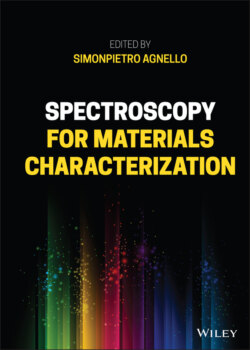Читать книгу Spectroscopy for Materials Characterization - Группа авторов - Страница 22
1.3.1 Typical Block Diagram of Spectrometers
ОглавлениеIn spectroscopy experiments, radiation–matter interaction is the fundamental process that should be investigated by the instrument. In every instrument, a source of radiation is needed and then, to analyze the effect, the radiation should be selected in terms of energy, or wavelength, and the influence on the sample to be investigated should be detected. Typical block diagrams for simple absorption and emission instruments are reported in Figure 1.7.
In a typical absorption experiment, a light source generates the electromagnetic wave. This is directed to a monochromator that is able to select a given wavelength (energy) of the lightwave within an opportune interval (bandwidth), depending on the construction parameters. The light impinges then on the sample that is opportunely inserted in its path. The light emerging from the sample is detected by a detector and its intensity is registered by a computer (not reported). As reported in Section 1.1.1, comparing the source intensity without the sample (I 0(λ)) and that after the passage through the sample (I t(λ)), an absorption measurement can be carried out. This kind of setup is known as single‐beam spectrophotometer and it needs a couple of measurements to record I 0(λ) and I t(λ). In some systems, a beam splitter is inserted before the sample to split the lightwave in two identical rays (see dashed path in Figure 1.7). This system is known as double‐beam spectrometer and uses the unperturbed ray as a reference to record I 0(λ) and the ray passing through the sample to “contemporarily” detect I t(λ). In this case, a great advantage is usually obtained by using a single detector to avoid mismatches of the spectral response of the detecting system [2, 10].
Figure 1.7 Pictorial representation of the instrumentations to carry out spectroscopy experiments. On the left, the components of an absorption spectrophotometer consisting of a light source, an entrance monochromator, the sample, and a detector are drawn. The double beam configuration is sketched by the beam splitter and the dashed arrow representing the reference beam. On the right, the scheme for an emission spectrofluorometer shows the additional exit monochromator and the side detector to record the emitted light.
In the photoluminescence experiment, a spectrofluorometer is used where the source of radiation is placed before one monochromator (entrance) to select the wavelength (energy) to excite the sample. When an emission process is active, this is typically isotropic in space and the emitted light can be recorded everywhere. Usually, to avoid any interference with the transmitted light, the emission is recorded in the 90° geometry shown in Figure 1.7 or, seldom, in backscattering geometry (the emitted light is recorded in the same direction as the exciting light, the impinging and emerging rays form 180° angle, not reported). To determine the characteristics of the emitted light, a second monochromator (exit) is inserted after the sample to select the wavelength (energy) of the light. Finally, a detector is inserted that is connected to a computer (not reported).
